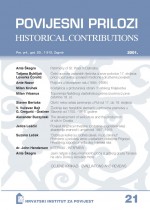Životinje kao heraldički elementi u grbovima plemstva u Slavoniji od 1700.-1918. godine
Animals as heraldic elements in the Coats of Arms of the aristocracy in Slavonia in the period 1700-1918
Author(s): Gordana Gregurić Grančer, Vesna Vučevac BajtSubject(s): History
Published by: Hrvatski institut za povijest
Summary/Abstract: In many coats of arms of the aristocratic families in Slavonia we find the animals or their parts as parts of the coats of arms. By these researches we have covered the coats of arms of the aristocratic families in Virovitica County, Poæega County and Sirmium County. Some of the displayed animals have their habitat in Slavonia (this refers especially to the birds), so this is the reason why they are displayed so often in the coats of arms. However, most of the animals shown on the coats of arms have religious and mythical characteristics. The most often displayed animal in the coats of arms of the Slavonic aristocracy in the mentioned period is the lion. Since the lion does not have its habitat in Slavonia, his appearance is linked to his attributive characteristics such as authority, strength, power, magnificence, courage, daring, attentiveness. It is exactly for these characteristics that the lion is the most frequently used heraldic element. In a large number of coats of arms the image of eagle appears as a counterpart to the image of lion and as the most important bird. As a bird of the monarchs, it symbolizes the heavenly equivalent to the lion on earth. The general opinion is that the double-headed eagle, also used in some of the family coats of arms, doubles the symbolism of eagle and its meaning. A griffon, a mythological creature drawn with the beak and wings of an eagle and the body of a lion, which came to the oat of arms of the Slavonic nobility under the influence of the Middle European heraldry, links the symbolism of the lion with the heavenly energy of the eagle. The wolf as a heraldic element appears mostly in the coats of arms of the Uskok (the Uskok pirates”) families. It can be assumed that its appearance in the coat of arms of the Delivuk family is linked to the fight of that family against the Turks, but also to the family name Delivuk (vuk = wolf, transl. note). As a symbol of triumph and glory, but also as an important element in the economy of that period, the horse found its place as a heraldic element in the coat of arms of the aristocratic families A deer, although linked to Slavonia with its habitat and displayed on the coat of arms of the Sirmium County from 1747, is contained in the coats of arms of only two families (Bubanović and Eltz). The goat, which is also a frequent domestic animal, is displayed only in the coat of arms of the Birčić family from Virovitica County. The medieval unicorn, a mythological creature displayed in the coats of arms of the three families (Jurković, Koićand Brnjaković) is a symbol of power, splendor and purity. On the basis of the legends and various folk beliefs on the habits and behavior of some of the animals, these animals became the holders of some positive characteristics and as such they are frequent heraldic elements displayed in the coats of arms. This is especially so with the birds.
Journal: Povijesni prilozi
- Issue Year: 2001
- Issue No: 21
- Page Range: 161-170
- Page Count: 10
- Language: Croatian

